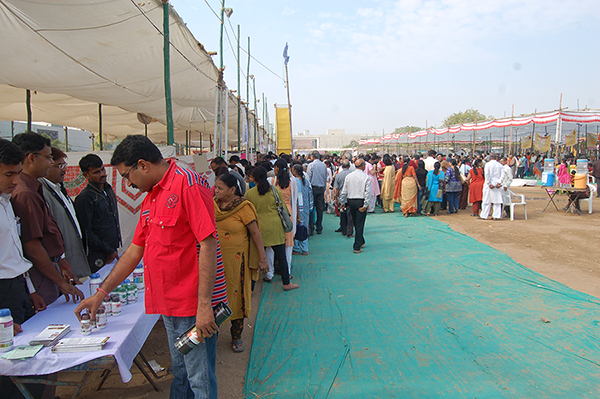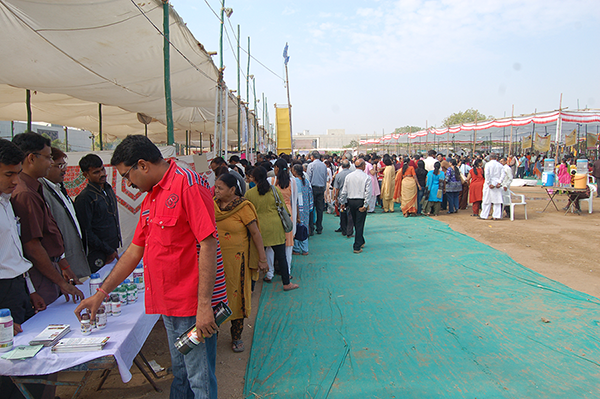7TH TRADITIONAL FOOD FESTIVAL
(19th to 21th December, 2009)
“A cultural milieu to revive the forgotten tastes and hence the forgotten ties!”
Date : 19th december to 21th December, 2009
Time : 11:00 AM – 10.00 PM
Venue : New Campus, IIM, Vastrapur, Ahmedabad

Report
The Seventh Traditional Food Festival reaffirmed the growing demand for traditional food items and organic products; coupled with a sustainable lifestyle. About forty thousand visitors thronged not only around the food counters, but also shopped to see different innovations and gadgets promoting a healthy life style.
Will Sattvik-2009 (19th to 21st December, 2009), trigger lasting changes in the food habit and life style remains to be seen. . details: For the populace of Ahmedabad, it was a rare opportunity to be able to appreciate more than 300 different traditional food recipes made out of a diverse range of plants and many with organically grown crop varieties.
The central theme was to discover and promote newer and sustainable ways of production as well as consumption of food and in the process create incentives for conservation of agro-biodiversity and healthy ecosystems
More than 40000 people visited the festival in three days. There were 80 stalls, a 20 percent rise from Sattvik- 2008. Apart from several districts from Gujarat, one could also see energetic participation from Jammu and Kashmir, Arunachal Pradesh, Rajasthan and some other states.
Healthy fast food for children
The members of Prakruti Mahila Gruh Udyog, Ahmedabad had come with natural sweet items like biscuits and ice-cream made only from dry fruits. Other healthy snacks were patties made of different spinach types, coconut kachori, grain pizzas, panipuri made from soybean ,Verdcourt, vadas, thepla and gota made of maize; organic bakery products like chocolates without cocoa, bread, toasts, pizza base,
biscuits and muffins made of fenugreek (Trigonella foenum-graecun L.) were also an attraction. Shilpaben, a primary school teacher, was extremely impressed by this concept. She said: “I always felt there was some need to find a solution for the harmful consumption patterns of modern day children. But if biscuits, pizzas, and ice-creams can be cooked in a healthy way, why worry?”
Health drinks: learning from users
Several health drinks caught the attention of visitors kashmiri tea ‘kehwa’ (good for general health of children), khati bhindi nu sharbat made from Abelmoschus moschatus Medic. (believed to cure urination problems, controls blood pressure and cholesterol), cocum syrup (reported useful for skin and hair related ailments), Ashtamrut soup made of tulsi (Ocimum sanctum L.), ginger, lemon and bilipatra and Panchratna sharbat (both are reportedly good for curing tonsils, bad cough and increase metabolism), suran nu soup made from (Amorphophallus campanulatus (Roxb.) Bl.ex Decne. said to reduce fat), herbal coffee, caffeine free tea, organic tea from Darjeeling and others.
Healthy food gave rise to some healthy learning too. For instance, Kajalben Soni, who sold saragva nu soup made from (Moringa oleifera Lam.) said, “I knew that this soup reduces cholesterol and is good for joints, but I learnt from some visitors that it also helps cure breast cancer.”
Jigna Joshi, who runs a cooking class in Ahmedabad said: “I was thrilled to know that kang no shiro is useful to pregnant mothers, children, is easily digestible and cures urination problems. I will surely teach its recipe to my customers.” An interesting stall was Gruh Udhyog : Dadima nu Vasam by Sanjay Joshi, which had produced 14 different items from amla (Indian gooseberry : Emblica officinalis Gaertn F.) at one single place.
NGOs, women groups and other social institutions
Sales-women from RUDI (Rural and Urban Development Initiative), a company initiated by SEWA, called themselves ‘Rudis’ with pride and sold agro-products like spices, pulses, and cereals along with items like ‘agarbattis’. It is hoped that they would move towards organic ingredients next time.
Women from Aadhar Mahila Seva Trust, a group of people infected and affected by HIV, sold khichadi made of several grains, soyabean cutlets and amla nu sharbat. They are involved in several seasonal businesses and work on the principle of providing employment to HIV infected people, at the same time, utilizing revenues generated for the betterment of such people.
The women were very much encouraged by the response they got but suggested that the Sattvik Festival be organized on 2nd or 4th Saturday of the month or around Christmas when maximum people can visit it.
An Ahmedabad based NGO ‘People for Animals’ which works for the basic rights of animals and birds had set up a stall to sell their literature and spread awareness about their cause. Mahendra Shrimali from the same group said: “We are ready to collaborate with SRISTI on projects of common interest.” Pitara Gujarat, an organization involved in primary education in Madhya Pradesh for 30 years exhibited books related to children. Their ARCH (Action Research in Community Health) group publishes health related literature in Gujarati. They also undertake students and teachers training in tribal areas of Gujarat.
Khedut Haat
More than 40 farmers from 30 different villages displayed their organic products at the Food Festival. The Khedut Haat looked flooded with fresh organically grown fruits like amla, lemon, guava, findla fal (Opuntia elatior Mill. Gard.) and others; food grains like wheat, basmati rice, pankhari rice (Oryza sativa L.), jowar;
spices like lili haldhar, jeeru (Cuminum cyminum L.), lilu lasan (Alliun sativum L.), lila dhana (Coriandrum sativum L.), lilo fudino and snacks like paunva. Items that attracted a lot of attention
were organic face pack, amla chavanprash, buttermilk masala, tulsi powder, henna powder, stavia (Stevia eupatoria )powder, Aloe vera juice and others.
Recipe Contest - Health all the way
A Recipe Contest was held on 18th December at IIM-A New Campus. The competition showed huge cultural and culinary diversity, when 40 participants displayed more than 120 different traditional dishes. Most of the recipes had some form of uniqueness either in terms of ingredients or in the way of cooking. Many items are reported to have healing qualities against specific lifestyle related disorders and other ailments.
Items like vegetable fala cake, rotlo made of fenugreek, bitter gourd and ragi (Eleusine coracana L.Gaertn), sabji made from fenugreek seeds, chapati made of nagli (Eleusine coracana L.Gaertn) and other items control diabetes. Sangitaben Soni, a participant said : “Doctors advise diabetic patients to eat crushed fenugreek dana powder, but sabji prepared out of the same is tasty and therefore one is more likely to eat it regularly. Additionally, people who are allergic to mango juice can consume it along with this sabji to get rid of the allergy.” Chayanikaben, winner of Recipe contest of 2008 prepared “halwa made of coconut”, “khajur drakshavadi” and “bhaji-mogra ni dhokli”; all items are iron-rich, solve acidity problems, increase memory power and should especially be consumed by women nearing menopause.
Many other items like ‘alachi na ladu’ made from (Elettaria cardamom) (good for waist pain, increases lactation in mothers without extra fat), ‘ragi ni sukhadi’, ‘saat dhan ni khichadi’ (made of seven different grains), ‘nimani na marcha’ (Capsicum annuum L.) and rotla’ (cures acidity), raita made of grapes (reportedly relieves from allergy due to curd), ‘Aloe vera roti’ (strengthens digestive system), wood apple jam were prepared and displayed.
Urvashi Parek won the First Prize for her ‘fangaveli kalathi nu salad’, ‘jav nu soup’ and ‘bathua ni bhaji’ (Chenopodium album L.) The first runner-up was Nirjaben Pradhan who prepared ‘ragi ni sukhadi’, ‘chil ni bhaji’, ‘luni muthia’ and ‘muthia of nagarvel leaves’. Vasantben Pandya became the second runner-up for her ‘kang na ladu’, a sweet dish made of Setaria italica. We hope to get entries for Sattvik 2010 from all over the country.
(Honey bee 20(4) & 21(1), 31 to 32, 2009 & 2010).


